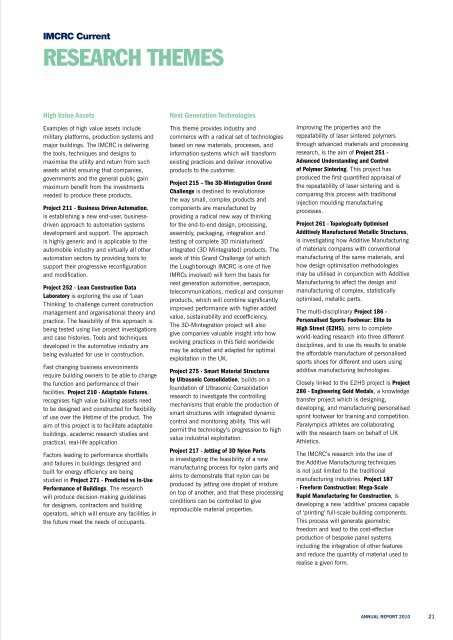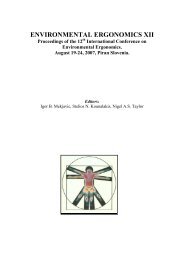ANNUAL REPORT 2010 - Loughborough University
ANNUAL REPORT 2010 - Loughborough University
ANNUAL REPORT 2010 - Loughborough University
Create successful ePaper yourself
Turn your PDF publications into a flip-book with our unique Google optimized e-Paper software.
IMCRC Current<br />
RESEARCh ThEMES<br />
high Value Assets<br />
Examples of high value assets include<br />
military platforms, production systems and<br />
major buildings. The IMCRC is delivering<br />
the tools, techniques and designs to<br />
maximise the utility and return from such<br />
assets whilst ensuring that companies,<br />
governments and the general public gain<br />
maximum benefit from the investments<br />
needed to produce these products.<br />
Project 211 - Business Driven Automation,<br />
is establishing a new end-user, businessdriven<br />
approach to automation systems<br />
development and support. The approach<br />
is highly generic and is applicable to the<br />
automobile industry and virtually all other<br />
automation sectors by providing tools to<br />
support their progressive reconfiguration<br />
and modification.<br />
Project 252 - Lean Construction Data<br />
Laboratory is exploring the use of ‘Lean<br />
Thinking’ to challenge current construction<br />
management and organisational theory and<br />
practice. The feasibility of this approach is<br />
being tested using live project investigations<br />
and case histories. Tools and techniques<br />
developed in the automotive industry are<br />
being evaluated for use in construction.<br />
Fast changing business environments<br />
require building owners to be able to change<br />
the function and performance of their<br />
facilities. Project 210 - Adaptable Futures,<br />
recognises high value building assets need<br />
to be designed and constructed for flexibility<br />
of use over the lifetime of the product. The<br />
aim of this project is to facilitate adaptable<br />
buildings, academic research studies and<br />
practical, real-life application.<br />
Factors leading to performance shortfalls<br />
and failures in buildings designed and<br />
built for energy efficiency are being<br />
studied in Project 271 - Predicted vs In-Use<br />
Performance of Buildings. The research<br />
will produce decision-making guidelines<br />
for designers, contractors and building<br />
operators, which will ensure any facilities in<br />
the future meet the needs of occupants.<br />
Next generation Technologies<br />
This theme provides industry and<br />
commerce with a radical set of technologies<br />
based on new materials, processes, and<br />
information systems which will transform<br />
existing practices and deliver innovative<br />
products to the customer.<br />
Project 215 – The 3D-Mintegration grand<br />
Challenge is destined to revolutionise<br />
the way small, complex products and<br />
components are manufactured by<br />
providing a radical new way of thinking<br />
for the end-to-end design, processing,<br />
assembly, packaging, integration and<br />
testing of complete 3D miniaturised/<br />
integrated (3D Mintegrated) products. The<br />
work of this Grand Challenge (of which<br />
the <strong>Loughborough</strong> IMCRC is one of five<br />
IMRCs involved) will form the basis for<br />
next generation automotive, aerospace,<br />
telecommunications, medical and consumer<br />
products, which will combine significantly<br />
improved performance with higher added<br />
value, sustainability and ecoefficiency.<br />
The 3D-Mintegration project will also<br />
give companies valuable insight into how<br />
evolving practices in this field worldwide<br />
may be adopted and adapted for optimal<br />
exploitation in the UK.<br />
Project 275 - Smart Material Structures<br />
by Ultrasonic Consolidation, builds on a<br />
foundation of Ultrasonic Consolidation<br />
research to investigate the controlling<br />
mechanisms that enable the production of<br />
smart structures with integrated dynamic<br />
control and monitoring ability. This will<br />
permit the technology’s progression to high<br />
value industrial exploitation.<br />
Project 217 - Jetting of 3D Nylon Parts<br />
is investigating the feasibility of a new<br />
manufacturing process for nylon parts and<br />
aims to demonstrate that nylon can be<br />
produced by jetting one droplet of mixture<br />
on top of another, and that these processing<br />
conditions can be controlled to give<br />
reproducible material properties.<br />
Improving the properties and the<br />
repeatability of laser sintered polymers<br />
through advanced materials and processing<br />
research, is the aim of Project 251 -<br />
Advanced Understanding and Control<br />
of Polymer Sintering. This project has<br />
produced the first quantified appraisal of<br />
the repeatability of laser sintering and is<br />
comparing this process with traditional<br />
injection moulding manufacturing<br />
processes.<br />
Project 261 - Topologically optimised<br />
Additively Manufactured Metallic Structures,<br />
is investigating how Additive Manufacturing<br />
of materials compares with conventional<br />
manufacturing of the same materials, and<br />
how design optimisation methodologies<br />
may be utilised in conjunction with Additive<br />
Manufacturing to affect the design and<br />
manufacturing of complex, statistically<br />
optimised, metallic parts.<br />
The multi-disciplinary Project 186 -<br />
Personalised Sports Footwear: Elite to<br />
high Street (E2hS), aims to complete<br />
world-leading research into three different<br />
disciplines, and to use its results to enable<br />
the affordable manufacture of personalised<br />
sports shoes for different end users using<br />
additive manufacturing technologies.<br />
Closely linked to the E2HS project is Project<br />
286 - Engineering gold Medals, a knowledge<br />
transfer project which is designing,<br />
developing, and manufacturing personalised<br />
sprint footwear for training and competition.<br />
Paralympics athletes are collaborating<br />
with the research team on behalf of UK<br />
Athletics.<br />
The IMCRC’s research into the use of<br />
the Additive Manufacturing techniques<br />
is not just limited to the traditional<br />
manufacturing industries. Project 187<br />
- Freeform Construction: Mega-Scale<br />
Rapid Manufacturing for Construction, is<br />
developing a new ‘additive’ process capable<br />
of ‘printing’ full-scale building components.<br />
This process will generate geometric<br />
freedom and lead to the cost-effective<br />
production of bespoke panel systems<br />
including the integration of other features<br />
and reduce the quantity of material used to<br />
realise a given form.<br />
AnnuAl RepoRt <strong>2010</strong> 21

















